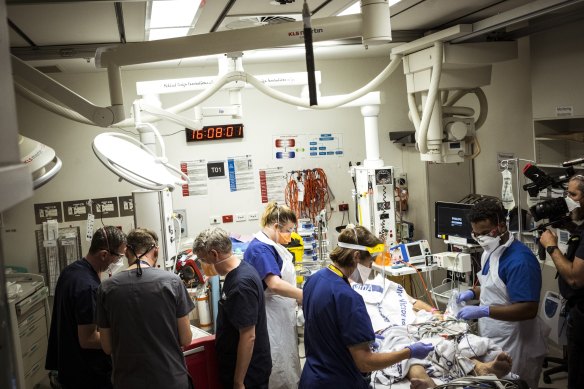This was published 3 years ago
Bonus payments for health workers to tackle hospital staffing crisis
By Melissa Cunningham and Aisha Dow
Frontline health workers in Victoria will receive $3000 in bonuses, as hospitals and emergency services try to retain exhausted and overworked staff and prepare for a difficult winter.
The Australian Medical Association and Victoria’s nurses union had called for the bonus payments, fearing a mass exodus of staff who are already leaving or scaling back their hours at a concerning rate after two gruelling years and an unrelenting wave of sick patients.

A man brought into the ED under cardiac arrest is worked on by the emergency team in the busy emergency department of the Royal Melbourne Hospital.Credit: Chris Hopkins
While the money is unlikely to fix a serious staffing shortage, it is hoped that it will help prevent some people leaving overwhelmed public hospitals, and may encourage others back to frontline roles, or to work longer hours.
“As everyone is suddenly noticing their mortgage repayments [going up and] the cost of living is increasing, it will allow people to examine their own circumstances, as to whether they really want to leave the system as bad as they thought,” said Dr Roderick McRae, the Victorian president of the Australian Medical Association.
The Victorian secretary of the Australian Nursing and Midwifery Federation, Lisa Fitzpatrick, said the staff shortages were so profound that nurse-to-patient ratios were not being met.
“In many instances nurses and midwives are holding the system together with redeployment, overtime and double shifts and some are hanging on by a thread,” she said.
“Acknowledgement is really important, but what we really hope is that nurses and midwives who have taken some time out may be able to return, so health services can start to fill the vacancies on rosters and we can start working within ratios again.”
On Thursday morning, Premier Daniel Andrews announced that all full-time staff working in public hospitals and ambulance services, including nurses, midwives, allied health professionals, paramedics, cleaners and ward clerks, would receive $3000.
The first retention and surge $1500 payment will be made on August 15, the second at the end of September, as part of the $353 million retention package which adds to a promised 7000 healthcare workers promised in the latest state budget.
Part-time and casual staff will also receive a payment, but how much they receive will be determined according to how many hours they work. If they increase their hours, they will be entitled to a larger payment, the government confirmed.
Other “practical help”, such as free meals, will also be provided.
It is another example of the Victoria Government moving in tandem with NSW; the announcement comes three days after the NSW government said it would give the state’s healthcare workers a $3000 one-off payment.
“This payment, I think, is very well deserved, and will have a real impact in bringing staff back,” Andrews said.
“This is all about encouraging people to take up a few extra shifts, if they can, to go from being part-time to maybe working some further hours. It’s also about bringing people back into the system who may have been out of the system for a period of time.
“And it’s also a fundamental acknowledgement of the extreme pressure ... the really significant challenge that there is in our health system at the moment, and trying to, not only express our gratitude but to incentivise and see more and more staff stay in our public hospital system.”
Doctors and paramedics have been warning that conditions in the state’s hospitals have recently deteriorated to the point that, for the first time, patients with critical illness or injuries are being forced to wait for care
Last month, a senior doctor at Melbourne’s major trauma centre, John Wilson, resigned, warning the situation was putting lives at risk and pushing healthcare workers to breaking point.
Speaking at Thursday’s press conference, the nurse unit manager at the Royal Melbourne Hospital’s emergency department, Susan Harding, said many good nurses had been lost to the pandemic, including burnout or early retirement.
“We can do amazing things in healthcare but if we don’t have the people to deliver that care, it becomes very lonely and impossible.”
The state government, alongside the AMA, has been pushing the federal government to increase its funding to public hospitals to 50 per cent, a move estimated to bring an extra $20 billion to the sector, nationally, over four years.
The issue will be on the table when Prime Minister Anthony Albanese meets with the premiers next week.
Federal Health Minister Mark Butler said the government would “sit down with premiers constructively and work through these issues”.
Our Breaking News Alert will notify you of significant breaking news when it happens. Get it here.